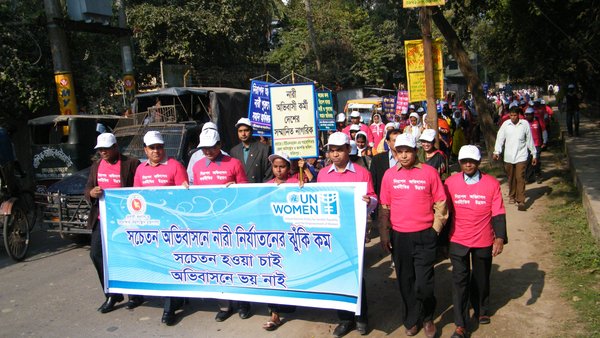
Addis Ababa, Ethiopia. 16 year old Hamza Mustapha joins other Saudi deportees outside the migrants rehabilitation center . UNICEF Ethiopia/2013/Ayene. CC BY-NC-ND 2.0 DEED
What does research in Nepal and Ethiopia reveal about the effectiveness of government efforts and continuing gaps that allow exploitation and inequality to persist?
For many people that move to improve their situation and prospects, the decision to migrate is usually driven by structural inequalities. Even though migration can help to reduce inequalities, it can also be associated with numerous injustices which serve to exacerbate inequalities, in both countries of origin and destination, as well as the countries through which migrants move.
This article focuses on two migration corridors, Ethiopia to South Africa and Nepal to Malaysia, that were part of the MIDEQ research. It explores the injustices and exploitation that migrants experience within their countries of origin and how this can adversely impact migrants in the countries they move through and to.
Migration from Nepal to Malaysia is typically regular and managed through a bilateral labour agreement; while irregular migration dominates the Ethiopia–South Africa corridor. Although these two migration routes are subject to distinct sets of laws and regulations, both international and national, both are impacted by migration-related injustices that perpetuate existing inequalities.
This raises two critical questions: What are the governments of Nepal and Ethiopia doing to address the situation and protect their citizens-turned-migrants? Are the preventive or corrective measures they’re taking proving to be effective?
Different migration pathways: A medley of actors and injustices
Migration from Nepal to Malaysia mainly occurs under the auspices of labour migration agreements between the two countries, meaning that the migration process is subject to a relatively high degree of regulation and formality. Over 90 per cent of labour migration, for instance, is handled by recruitment agencies.
Migration from Ethiopia to South Africa presents a contrasting scenario. Research by both MIDEQ and others reveals that a substantial number of migrants, mostly from Southern Ethiopia, travel to South Africa using irregular pathways, often travelling by road through several countries. Migration along this route tends to operate outside the remit of the law, shrouded in illegality. Yet it continues to persist as a migration pathway of choice since those who undertake the journey consider the benefits of migration to outweigh the risks and costs.
A common factor that exists between these seemingly contrasting scenarios is the dominant role of migration intermediaries, those who foster, facilitate or sustain human mobility. Along the Nepal–Malaysia corridor, for instance, recruitment agencies are generally regulated and required to act in accordance with the law or else risk penalty. Along the Ethiopia–South Africa corridor, however, informal networks of brokers, both local and transnational, play multiple roles, including arranging travel documents, transportation, accommodation, and navigation across multiple borders and countries. Human rights violations and gross abuses of smuggled migrants to South Africa are well documented, ranging from financial exploitation and inhuman and cruel treatment to detention (for example, around 5000 Ethiopians were reported to be languishing in Tanzanian prisons in 2022) and even death. Most exploitation and injustice is rarely redressed.
Labour migration from Nepal to Malaysia, despite its government regulation, is also mired in complaints of exploitation, abuses, and injustice. Migrants complain of high recruitment fees, even when low or no fees should be charged, contract substitution, fake documentation, deception, visa trading, and passport confiscation, among others. A report by the International Labour Organization (ILO) regards this exploitation as the norm rather than the exception, owing to the unethical behaviour of migration intermediaries.
These two migration pathways illustrate how migrants remain largely vulnerable and at the mercy of the very persons or agents who they contract to facilitate their migration in the hope of improving their livelihoods. So, what are the respective governments doing to address these injustices and are these measures sufficient?
Government responses in Nepal
Nepal is party to several international human rights instruments and ILO Conventions, which, in its Labour Migration Report 2022, claims “act as guiding frameworks for the management and regulation of national and global labour migration.” Additionally, Nepal has participated in both international and regional forums and frameworks aimed at improving labour recruitment regulation and monitoring. These include the Global Compact for Safe, Orderly and Regular Migration, the Colombo Process, the Abu Dhabi Dialogue, the ILO’s Fair Recruitment Initiative, and the Multilateral Framework on Labour Migration.
Nepal’s participation in, and continuing reference to, these processes and frameworks indicates its awareness of the unethical behaviours and exploitation in its labour migration industry, and that it is willing to take steps individually and jointly with other States and organisations to address it. Nonetheless, it has still not yet ratified some key international treaties such as the Migrant Workers Convention, the Domestic Workers Convention, and the Private Employment Agencies Convention. These Conventions create legally binding obligations for State parties to accord enhanced and specific protections to specified categories of persons, and promote fair and ethical recruitment practices.
Given the predominant role of the private sector in the facilitation of labour migration, the Government’s role is essentially to regulate and monitor the operation of private agents. The Government of Nepal enacted the Foreign Employment Act and its regulations in 2007 and adopted a foreign employment policy. Both law and policy require private agencies to, inter alia, only operate under a license that is renewed annually, to submit periodic reports of all persons recruited and fees charged, and to submit to regular inspections from government authorities.
The role of overseeing the management and regulation of labour migration and ensuring legal and policy compliance lies with a number of bodies and agencies. Key among these are specialized sections within the Ministry of Labour, Employment and Social Security, the Department of Foreign Employment, the Foreign Employment Board, and the Foreign Employment Tribunal. Recent years have witnessed an increase rather than a decline in complaints of abuses and exploitations to these bodies. Between 2019 and 2022 the number of reported fraud and scam cases increased from 445 to 2,108, and contract substitution cases from 98 to 689. These figures might not only be indicative of the scale of injustices in labour recruitment but might also be due to an increased awareness among migrant workers about their rights and means of redress.
In its Labour Migration Report 2022, the Government of Nepal acknowledges that migrant workers’ access to redress and complaint mechanisms remains a challenge, mainly owing to migrants’ ignorance of laws and institutions, their reluctance to complain, and lack of evidence. Independent reports, however, have pointed out a number of weaknesses in government processes. These include not strictly adhering to licensing procedures, under resourcing oversight bodies, and weak coordination among various government bodies and agencies.
Additionally, corruption is widely perceived to be a problem in Nepal, and if widespread in the labour migration industry, could frustrate efforts to improve the accountability of recruitment agencies and the effectiveness of government monitoring and enforcement mechanisms. Relatedly, the Rule of Law index indicates that respect for fundamental human rights and the rule of law in Nepal have been on the decline since 2015, suggesting that government mechanisms to protect Nepalese workers who suffer injustices may fall short.
Government responses in Ethiopia
Turning to irregular migration from Ethiopia, the Government of Ethiopia is equally aware of the problem and has demonstrated its commitment to tackling irregular migration by ratifying key international treaties against trafficking in persons and the smuggling of migrants. It is also a member of the regional Inter-Governmental Authority on Development whose migration policy framework sets out clear plans for addressing these issues.
Domestically, Ethiopia has enacted laws and policies to deal with human trafficking, migrant smuggling, and irregular migration generally. These include the 2020 Proclamation to provide for the Prevention and Suppression of Trafficking in Persons and the Smuggling of Persons (which replaced a 2015 law deemed inadequate), the 2003 Immigration Proclamation, the draft National Migration Policy, and the 2018 National Reintegration Directive. The 2020 Proclamation also establishes a National Council to coordinate the implementation of the law; underneath the Council sits a National Partnership Coalition and regional partnership coalitions.
Despite these efforts, reports suggest that any progress in Ethiopia’s handling of migrant smuggling has been limited in comparison to its efforts to address human trafficking. This could partly be due to the fact that brokers/smugglers are seen by the persons that use their services as facilitators of movement rather than as criminals, reflected in underreporting of the problem. This is coupled with a lack of proper coordination and systematic organisation among the oversight and enforcement agencies, which are inadequately resourced and funded.
Brokers/smugglers reportedly bribe border officials along the migration route, bribe law enforcement officers when arrested, and may have even involved some government officials in their operations. The perception of corruption and the failure to effectively deal with it further blights government efforts to combat migrant smuggling and irregular migration.
The political situation in Ethiopia continues to be fragile and is characterized by ethnic divisions and civil unrest, which not only diverts government resources, but also detracts from any meaningful progress in tackling irregular migration. Instead, the unrest creates conditions in which it festers. This situation is made worse by Ethiopia’s long and porous borders with neighbours that are also grappling with internal conflicts and instability.
Lessons learned from Ethiopia and Nepal
Both case studies highlight the vulnerabilities of migrants; both those who journey under labour migration arrangements and those who migrate irregularly. The injustices experienced by Nepalese and Ethiopian migrants expose structural inequalities in the right to move and the conditions under which migration takes place; especially where these injustices are neither effectively addressed nor redressed. The Governments of Nepal and Ethiopia are aware of the problems, know what their international and domestic obligations are, and have taken positive steps to protect their citizens from abuses, exploitation, and injustices. But there is still more that needs to be done.
Both countries need to demonstrate actual protection and respect for the human rights of their citizens. They should, for instance, strengthen the institutions and mechanisms they have established to address the problems their citizens face during the migration process. They should respond to reported inefficiencies and shortcomings by ensuring relevant institutions are well-resourced and function effectively.
Problems and injustices associated with migration are clearly transnational in nature and call for international cooperation. Efforts are being made in various international and regional fora, but it is important to move from rhetoric to practice. States need to demonstrate the political will to address injustice, individually and in partnership with local and international partners. Governments need to deliver on their human rights obligations by practically implementing a human-rights based approach to migration, to ensure better respect and protection of the rights of individuals who migrate.



